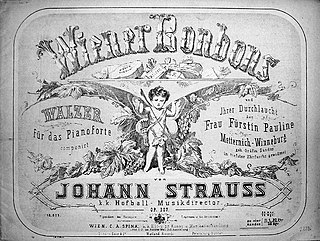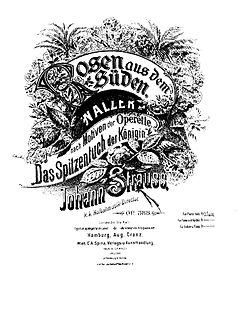
Johann Baptist Strauss II, also known as Johann Strauss Jr., the Younger, the Son, was an Austrian composer of light music, particularly dance music and operettas. He composed over 500 waltzes, polkas, quadrilles, and other types of dance music, as well as several operettas and a ballet. In his lifetime, he was known as "The Waltz King", and was largely responsible for the popularity of the waltz in Vienna during the 19th century. Some of Johann Strauss's most famous works include "The Blue Danube", "Kaiser-Walzer", "Tales from the Vienna Woods", "Frühlingsstimmen", and the "Tritsch-Tratsch-Polka". Among his operettas, Die Fledermaus and Der Zigeunerbaron are the best known.

Wiener Bonbons, Op. 307, is a waltz by Johann Strauss II written in 1866. It was first performed on 28 January 1866 at the ball of the Association of Industrial Societies held in the ball rooms of the Vienna Hofburg and was dedicated to the influential Princess Pauline Metternich-Winneburg, the wife of then Austrian ambassador to Paris.

Joseph Franz Karl Lanner was an Austrian dance music composer and dance orchestra conductor. He is best remembered as one of the earliest Viennese composers to reform the waltz from a simple peasant dance to something that even the highest society could enjoy, either as an accompaniment to the dance, or for the music's own sake. He was just as famous as his friend and musical rival Johann Strauss I, who was better known outside of Austria in their day because of his concert tours abroad, in particular, to France and England.

The Kuss-Walzer, Op. 400 is a waltz by Johann Strauss II composed in 1881. The waltz was originally dedicated to his second wife, Angelika Dittrich (1850–1919), but Strauss withdrew that dedication after their divorce in 1882. The waltz comprises melodies from Strauss' popular operetta Der lustige Krieg and is an orchestral treatment of the act 2 aria "Nur für Natur" which was a hit when first performed. Eduard Strauss, the composer's brother, first conducted the orchestral piece at the Court Ball in Vienna in 1882.

Rathausball-Tänze op. 438 is a waltz by composer Johann Strauss II written in 1890 in honour of the inauguration of the new city hall of Vienna. At the opening of the new banqueting hall (Festsaal) on 12 February 1890 two rival orchestras were commissioned to provide dance music for the occasion; the Strauss Orchestra under the direction of Eduard Strauss, and that of rival Kapellmeister Karl Michael Ziehrer who was head of the Vienna House Regiment 'Hoch und Deutschmeister No. 4'.
Liebeslieder op. 114 is a waltz by Johann Strauss II written in 1852. At the time it was conceived, the waltz was titled 'Liebesgedichte' or "Love Poems" and during its first performance, it was even announced as 'Liebesständchen' or "Love Serenade". The first performance was at the famed Vienna Volksgarten on 18 June 1852 under the composer's direction.

Rosen aus dem Süden, Op. 388, is a waltz medley composed by Johann Strauss II in 1880 with its themes drawn from the operetta Das Spitzentuch der Königin. Strauss dedicated the waltz to King Umberto I of Italy.
Aschenbrödel (Cinderella) is a ballet written by Johann Strauss II. He had written all the principal parts of the ballet, and was intending to fill in the orchestration as time permitted. However, Strauss died in 1899, and it was finished by composer Josef Bayer in 1900.
Feenmärchen (Fairy-tales) waltz op. 312 is composed by Johann Strauss II in 1866. The same year had witnessed the glaring military weakness of the ailing Habsburg dynasty after a bitter defeat to the hands of the Prussian army at the fateful Battle of Königgrätz. Almost immediately, various Vienna's establishments usually packed with music-lovers dancing the night away took the news with foreboding and many of the year's festivities were cancelled or with-held.
Nachtfalter (Moths) op. 157 is a waltz by Johann Strauss II written in 1854. The waltz was first performed at a parish festival ball at Unger's Casino in the suburb of Hernals, Vienna on 28 August of the same year.
Morgenblätter, Op. 279, is a Viennese waltz composed by Johann Strauss II in 1863 and first performed on 12 January 1864 at the Sofiensaal in Vienna. The work's genesis was attributed to the composition of a waltz by Jacques Offenbach later titled "Abendblätter" when the Offenbach dedicated his work to the influential Vienna Authors' and Journalists' Association. The association had earlier intended the "Abendblätter" waltz to be played at their Concordia Ball on 12 January 1864.

Wiener Blut Op. 354 is a waltz by Johann Strauss II first performed by the composer on 22 April 1873. The new dedication waltz was to celebrate the wedding of the Emperor Franz Joseph I's daughter Archduchess Gisela Louise Maria and Prince Leopold of Bavaria. However, the waltz was also chiefly noted by Strauss' biographers as the début of Strauss with the Vienna Philharmonic Orchestra where for many years, the Philharmonic had dismissed any association with the 'Waltz King' as it had not wished to be associated with mere 'light' or 'pops' music. The festival ball celebrating the event was held at the Musikverein Hall which is the venue for the present day Neujahrskonzert.
Neu Wien , opus 342, is a waltz written by Johann Strauss II in 1870 and dedicated to Nicolaus Dumba (1830-1900), who was a fervent patron of Arts and was the Chairman of the Wiener Männergesang-Verein and Vice-President of the Gesellschaft der Musikfreunde in Wien.
Karnevalsbotschafter op. 270 is a waltz composed by Johann Strauss II in the autumn of 1862. Incidentally, it was also written during Strauss' honeymoon with his first wife Henrietta Treffz in Venice. It was first performed at the 50th anniversary celebration of the Vienna's Gesellschaft der Musikfreunde at the 'Sperl' dance hall on 11 November 1862 and also at a soirée there on 22 November. The title may be alluded to Strauss himself, as a 'carnival ambassador' to Venice having accomplished the year's Fasching festivity commitments in Vienna. Unsurprisingly for him in Venice, although his wife had intended the honeymoon as a complete rest for him, he found himself duly inspired to pen this lovely waltz in a period of great personal happiness.
"Frühlingsstimmen", Op. 410 is an orchestral waltz, with optional solo soprano voice, written in 1882 by Johann Strauss II.
Schatz-Walzer, Op. 418, is a Viennese waltz by Johann Strauss II composed in 1885. The melodies from this waltz were drawn from Strauss' operetta Der Zigeunerbaron which premiered to critical acclaim on 24 October 1885. This waltz was first performed on 22 November that year in the concert hall of the Vienna Musikverein with Eduard Strauss conducting.

Waltzes from Vienna is a 1934 British biographical film directed by Alfred Hitchcock, sometimes known as Strauss' Great Waltz. It was part of the cycle of operetta films made in Britain during the 1930s.
Mephistos Höllenrufe, Op. 101, is a waltz composed by Johann Strauss II in 1851. It was first performed at the Vienna Volksgarten as part of a festival preceding Strauss' departure for a tour of Germany. The title of the composition is a quotation from the Bible: "And the devil [Mephistopheles] [...] was cast into the lake of fire and brimstone, where the beast and the false prophet are, and shall be tormented day and night for ever and ever". A reporter for the Wiener Allgemeine Theaterzeitung commented on Strauss' waltz that it "received such a favourable reception, on account of its effective and original melodies and brilliant instrumentation, that it had to be repeated three times". Especially colourful, and keeping with the work's ominous title, is the second waltz theme: its cheerful, ascending tune is suddenly interrupted, and then answered by a sinister chromatic descending passage. Some of the waltz themes of the work are found in close proximity to one another in the earliest of Strauss' "sketchbooks", and were probably written in the first half of 1851.
Farewell to America is the name of a waltz composed by Johann Strauss II. In the immediate wake of the composer's visit to the United States in the summer of 1872, when he conducted several times in Boston and New York, no less than seven publishers issued waltzes supposedly composed by Strauss. Only two from the total of nine compositions that were published are known to have been performed by Strauss during his tour of the United States: the Jubilee Waltz and the Manhattan Waltzes. It is unknown whether or not the other compositions that were published were written by Strauss while he was in America, completed by him after his return to Vienna and sent through the mail, or that some of the publications had nothing to do with Strauss himself, but were compiled by publishers anxious to benefit from Strauss' American tour and the clamour for new Strauss music.
Waltz War is a 1933 German musical comedy film directed by Ludwig Berger and starring Renate Müller, Willy Fritsch and Paul Hörbiger. It is loosely based on the rivalry between waltz composers Joseph Lanner and Johann Strauss I, as well as the life of the Austrian ballet dancer Katti Lanner who eventually settled in Victorian Britain. It is also known by the alternative title of The Battle of the Walzes.









